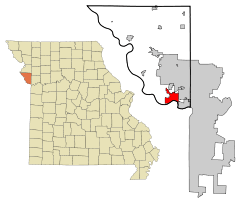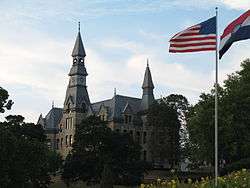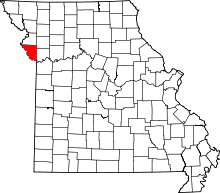Parkville, Missouri
| Parkville, Missouri | |
|---|---|
| City | |
|
McKay Hall at Park University | |
 Location of Parkville, Missouri | |
 | |
| Coordinates: 39°11′44″N 94°41′1″W / 39.19556°N 94.68361°WCoordinates: 39°11′44″N 94°41′1″W / 39.19556°N 94.68361°W | |
| Country | United States |
| State | Missouri |
| County | Platte |
| Area[1] | |
| • Total | 15.41 sq mi (39.91 km2) |
| • Land | 14.79 sq mi (38.31 km2) |
| • Water | 0.62 sq mi (1.61 km2) |
| Elevation | 827 ft (252 m) |
| Population [2] | |
| • Total | 10,025 |
| • Density | 596.34/sq mi (230.25/km2) |
| Time zone | Central (CST) (UTC-6) |
| • Summer (DST) | CDT (UTC-5) |
| ZIP codes | 64092-64151-64152-64153 |
| Area code(s) | 816 |
| FIPS code | 29-56288[3] |
| GNIS feature ID | 0730174[4] |
| Website | parkvillemo.gov |
Parkville is a city in Platte County, Missouri, United States. The population was 10,025 at the 2015 United States Census Parkville is known for its antique shops, art galleries, and historic downtown. The city is home to Park University and English Landing Park.
History
Parkville is named for George S. Park[5] who bought the steamboat landing concession on the Missouri River from David English in 1838 shortly after the Platte Purchase from the Native Americans opened the area for settlement. He served as the town's first postmaster.[6]
In 1845, he organized the Parkville Presbyterian Church which is still one of the town's largest congregations.
In 1853, he started the Industrial Luminary, a newspaper some believed to abolitionist. Park, however, termed the newspaper pro-commerce. Park generally believed that slavery in Kansas would be bad for his business interests there.
In 1854, while leading a trip up the Kansas River, he established the town of Polistra near the mouth of the Big Blue River.
Park's newspaper was raided by a pro-slavery mob on April 14, 1855, and the printing press was thrown in the Missouri River. Park was in Polistra at the time closing a deal to turn over the town into a newly named Boston, Kansas to be run by members of the abolitionist New England Emigrant Aid Company (who in turn would rename it Manhattan). The Parkville Luminary, a newspaper based on the original Luminary, began publishing again in 2004 and is circulated every Friday. The newspaper's first issue contained unpublished letters from Park's last issue and frequently reprints Park's own editorials from the original Luminary.
In 1859, he promoted the Parkville and Grand River Railroad to build the first bridge across the Missouri River. Park lost the battle to Kansas City when the Hannibal Bridge opened in 1869 making it the dominant city in the region.
In 1875, he donated land for what would become Park University on the bluffs above the Missouri River. His former home is a prominent part of the campus, visible from the entrance and serving as the school's alumni center.
Geography
Parkville is located at 39°11′44″N 94°41′1″W / 39.19556°N 94.68361°W (39.195602, -94.683636).[7] According to the United States Census Bureau, the city has a total area of 15.41 square miles (39.91 km2), of which, 14.79 square miles (38.31 km2) is land and 0.62 square miles (1.61 km2) is water.[1]
Demographics
| Historical population | |||
|---|---|---|---|
| Census | Pop. | %± | |
| 1850 | 309 | — | |
| 1880 | 482 | — | |
| 1890 | 769 | 59.5% | |
| 1900 | 931 | 21.1% | |
| 1910 | 765 | −17.8% | |
| 1920 | 619 | −19.1% | |
| 1930 | 636 | 2.7% | |
| 1940 | 671 | 5.5% | |
| 1950 | 1,186 | 76.8% | |
| 1960 | 1,229 | 3.6% | |
| 1970 | 1,253 | 2.0% | |
| 1980 | 2,091 | 66.9% | |
| 1990 | 2,402 | 14.9% | |
| 2000 | 4,059 | 69.0% | |
| 2010 | 5,554 | 36.8% | |
| Est. 2016 | 10,025 | [8] | 80.5% |
2010 census
As of the census[2] of 2016, there were 10,025 people, 2,053 households, and 1,469 families residing in parkville. There were 2,726 housing units at an average density of 596.34 per square mile (230.2/km2). The racial makeup of the city was 89.5% White, 4.0% African American, 0.1% Native American, 3.0% Asian, 0.3% Pacific Islander, 0.6% from other races, and 2.5% from two or more races. Hispanic or Latino of any race were 3.7% of the population.
There were 2,053 households of which 37.4% had children under the age of 18 living with them, 63.6% were married couples living together, 6.6% had a female householder with no husband present, 4.2% had a male householder with no wife present, and 25.6% were non-families. 20.9% of all households were made up of individuals and 5.8% had someone living alone who was 65 years of age or older. The average household size was 2.61 and the average family size was 3.05.
The median age in the city was 39.1 years. 25.6% of residents were under the age of 18; 12.7% were between the ages of 18 and 24; 20% were from 25 to 44; 32.6% were from 45 to 64; and 9.1% were 65 years of age or older. The gender makeup of the city was 49.4% male and 50.6% female.
2000 census
As of the census[3] of 2000, there were 4,059 people, 1,510 households, and 1,060 families residing in the city. The population density was 586.9 people per square mile (226.5/km²). There were 1,587 housing units at an average density of 229.5 per square mile (88.5/km²). The racial makeup of the city was 90.37% White, 4.71% African American, 0.52% Native American, 1.31% Asian, 0.96% Pacific Islander, 0.81% from other races, and 1.33% from two or more races. Hispanic or Latino of any race were 2.27% of the population.
There were 1,510 households out of which 37.4% had children under the age of 18 living with them, 59.1% were married couples living together, 7.7% had a female householder with no husband present, and 29.8% were non-families. 23.8% of all households were made up of individuals and 5.6% had someone living alone who was 65 years of age or older. The average household size was 2.54 and the average family size was 3.04.
In the city the population was spread out with 26.4% under the age of 18, 12.4% from 18 to 24, 29.9% from 25 to 44, 25.2% from 45 to 64, and 6.1% who were 65 years of age or older. The median age was 36 years. For every 100 females there were 95.0 males. For every 100 females age 18 and over, there were 93.5 males.
The median income for a household in the city was $68,600, and the median income for a family was $86,820. Males had a median income of $64,917 versus $31,740 for females. The per capita income for the city was $33,119. About 5.0% of families and 6.5% of the population were below the poverty line, including 8.1% of those under age 18 and 3.3% of those age 65 or over.
Education
The city is home to Park University.
Notable people
- Bill Grigsby, American sportscaster and member of the Missouri Sports Hall of Fame.
- George S. Park, Texas War of Independence hero, and founder of Parkville, Park University, and Manhattan, Kansas.
In popular culture
In Mark Twain's novel The Adventures of Huckleberry Finn (1884), Huck, Jim, "the king" and "the duke" crash a religious camp meeting in a town called Parkville, where "the king" lies to the crowd that he is an ex-pirate who was robbed and needs money to return to the Indian Ocean to convert other pirates to Christianity, for which a collection is taken from the crowd. This may actually be a fictitious town in Arkansas called Parkville, which Huck Finn describes as "a little one-horse town about three mile down the bend [of the Mississippi River].
In the Menagerie trilogy by Tui and Kari Sutherland, there was a menagerie in Parkville that was shut down due to it being exposed to the public.[10]
References
- 1 2 "US Gazetteer files 2010". United States Census Bureau. Archived from the original on January 24, 2012. Retrieved 2012-07-08.
- 1 2 "American FactFinder". United States Census Bureau. Retrieved 2012-07-08.
- 1 2 "American FactFinder". United States Census Bureau. Archived from the original on September 11, 2013. Retrieved 2008-01-31.
- ↑ "US Board on Geographic Names". United States Geological Survey. 2007-10-25. Retrieved 2008-01-31.
- ↑ Eaton, David Wolfe (1917). How Missouri Counties, Towns and Streams Were Named. The State Historical Society of Missouri. p. 342.
- ↑ http://www.parkvillemo.org/the-history-of-parkville-missouri/
- ↑ "US Gazetteer files: 2010, 2000, and 1990". United States Census Bureau. 2011-02-12. Retrieved 2011-04-23.
- ↑ "Annual Estimates of the Resident Population for Incorporated Places: April 1, 2010 to July 1, 2015". Retrieved July 2, 2016.
- ↑ "Census of Population and Housing". Census.gov. Archived from the original on May 11, 2015. Retrieved June 4, 2015.
- ↑ Twain, Mark, "Chapter XX: What Royalty Did to Parkville," in The Adventures of Huckleberry Finn, New York: Grosset & Dunlap, 1948, p. 167-170. In suits Season 2 episode 15 Normandy, Harvey and Scotty travel to Parkville to depose a women on a gender discrimination case.
External links
- City of Parkville
- Parkville Chamber of Commerce
- The Landmark, newspaper
- The Platte County Citizen, newspaper


